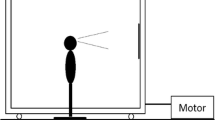Abstract
When standing human subjects are exposed to a moving visual environment, the induced postural sway forms a stable temporal relationship with the visual information. We have investigated this relationship experimentally with a new set-up in which a computer generates video images which correspond to the motion of a 3D environment. The suggested mean distance to a sinusoidally moving wall is varied and the temporal relationship to induced sway is analysed (1) in terms of the fluctuations of relative phase between visual and sway motion and (2) in terms of the relaxation time of relative phase as determined from the rate of recovery of the stable relative phase pattern following abrupt changes in the visual motion pattern. The two measures are found to converge to a well-defined temporal stability of the action-perception cycle. Furthermore, we show that this temporal stability is a sensitive measure of the strength of the action-perception coupling. It decreases as the distance of the visual scene from the observer increases. This fact and the increase of mean relative phase are consistent with predictions of a linear second-order system driven by the visual expansion rate. However, the amplitude of visual sway decreases little as visual distance increases, in contradiction to the predictions, and is suggestive of a process that actively generates sway. The visual expansion rate on the optic array is found to decrease strongly with visual distance. This leads to the conclusion that postural control in a moving visual environment cannot be understood simply in terms of minimization of retinal slip, and that dynamic coupling of vision into the postural control system must be taken into account.
Similar content being viewed by others
References
Asten WNJC van, Gielen CCAM, Denier van der Gon JJ (1988a) Postural adjustments induced by simulated motion of differently structured environments. Exp Brain Res 73:371–383
Asten WNJC van, Gielen CCAM, Denier van der Gon JJ (1988b) Postural movements induced by rotations of visual scenes. J Opt Soc Am [A] 5:1781–1789
Ball K, Pierowsky M (1987) A modified direct linear transformation method (DLT) calibration procedure to improve the accuracy of 3d reconstruction for large volumes. In: Groot G de, Hollander AP, Huijing PA, Ingen Schenau GJ van (eds) Biomechanics XI-B. (International series on biomechanics, vol 7-B), Free University, Amsterdam
Batschelet E (1981) Circular statistics in biology. Academic Press, London
Berthoz A, Lacour M, Soechting J, Vidal P (1979) The role of vision in the control of posture during linear motion. Prog Brain Res 50:197–209
Carter GC (1987) Coherence and time delay estimation. In: Lacoume JL, Durrani TS, Stora R (eds) Signal processing, vol 65. Les Mouches, Session XLV. Eisevier, Amsterdam
Dichgans J, Brandt T (1978) Visual-vestibular interaction: effects on self-motion perception and postural control. In: Held R, Leibowitz HW, Teuber HL (eds) Perception (Handbook of sensory physiology, vol 8) Springer, Berlin Heidelberg New York
Dijkstra TMH, Gielen CCAM, Melis BJM (1992) Postural responses to stationary and moving scenes as a function of distance to the scene. Hum Movement Sci 11:195–203
Fisher SK, Ciufredda KJ (1988) Accommodation and apparent distance. Perception 17:609–621
Hays WL (1988) Statistics. Holt, Rinehart and Winston, Orlando, Fa
Horn BKP (1987) Closed-form solution of absolute orientation using unit quaternions. J Opt Soc Am [A] 4:629–642
Lee DN (1980) The optic flow field: the foundation of vision. Philos Trans R Soc Lond [Biol] 290:169–179
Lee DN, Lishman JR (1975) Visual proprioceptive control of stance. J Hum Movement Stud 1:87–95
Lestienne F, Soechting J, Berthoz A (1977) Postural readjustments induced by linear motion of visual scenes. Exp Brain Res 28:363–384
Marmarelis PZ, Marmarelis VZ (1978) Analysis of physiological systems: the white-noise approach. Plenum Press, New York
Marple SL (1987) Digital spectral analysis with applications. Prentice Hall, Englewood Cliffs, NJ
Paulus W, Straube A, Krafczyk S, Brandt T (1989) Differential effects of retinal target displacement, changing size and changing disparity in the control of anterior/posterior and lateral body sway. Exp Brain Res 78:243–252
Schöner G (1991) Dynamic theory of action-perception patterns: the “moving room” paradigm. Biol Cybern 64:455–462
Schöner G, Kelso JAS (1988) Dynamic pattern generation in behavioural and neural systems. Science 239:1513–1520
Schuster D, Talbott RE (1980) Optimal and adaptive control in canine postural regulation. Am J Physiol 239:R93-R114
Stoffregen TA (1986) The role of optical velocity in the control of stance. Percept Psychophys 39:355–360
Tresilian JR (1991) Empirical and theoretical issues in the perception of time to contact. J Exp Psychol Hum Percept Perform 17:865–876
Author information
Authors and Affiliations
Rights and permissions
About this article
Cite this article
Dijkstra, T.M.H., Schöner, G. & Gielen, C.C.A.M. Temporal stability of the action-perception cycle for postural control in a moving visual environment. Exp Brain Res 97, 477–486 (1994). https://doi.org/10.1007/BF00241542
Accepted:
Issue Date:
DOI: https://doi.org/10.1007/BF00241542




